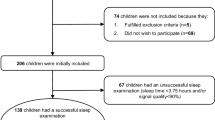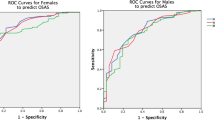Abstract
Background
Sleep-disordered breathing is caused by the interaction of multiple factors, including tonsillar hypertrophy, retrognathia, maxillary atresia, neuromuscular abnormalities, activation of inflammatory mediator cascades, and obesity. The prevalence and severity of obesity among children and adolescents increased worldwide during recent decades and has thus become a public health concern. The aim of this study is to assess the metabolic and anthropometric changes associated with sleep-disordered breathing in obese children.
Methods
Prospective assessment of prepubertal obese children followed at a pediatric endocrinology outpatient clinic that had history of frequent snoring. Children were submitted to polysomnography, measurements of body weight, height, blood pressure, neck circumference, and waist circumference. BMI, neck-to-height, and waist-to-height ratios were calculated. Laboratory tests included a complete blood count, liver function tests, lipid profile, and glucose metabolism assessment. Additionally, the presence of metabolic syndrome was assessed. Differences between obstructive sleep apnea and primary snoring groups were calculated using unpaired t-test, Fisher’s exact test or Mann-Whitney test (p < 0.05).
Results
The sample included 20 children with primary snoring and nine with obstructive sleep apnea. The two groups did not differ with regard to age, gender, BMI, or BMI z-score, serum lipids, glucose metabolism, cell count, liver function, or arterial blood pressure. Anthropometric data did not differ between groups. The waist-to-height ratio was greater among children with obstructive sleep apnea, compared to those with primary snoring.
Conclusion
In the present study, the waist-to-height ratio was greater in children with obstructive sleep apnea and, thus, could distinguish these children from those with primary snoring.
Similar content being viewed by others
References
Au CT, Li AM (2009) Obstructive sleep breathing disorders. Pediatr Clin N Am 56:243–259
Ali JN, Pitson D, Stradling JR (1993) Snoring, sleep disturbance, and behavior in 4–5 year olds. Arch Dis Child 68:360–366
Capdevila OS, Kheirandish-Gozal L, Dayyat E, Gozal D (2008) Pediatric obstructive sleep apnea: complications, management, and long-term outcomes. Proc Am Thorac Soc 5:274–282
Marcus CL, Brooks JL, Ward LD, Draper KA, Gozal G, Halbower AC (2012) Diagnosis and management of childhood obstructive sleep apnea syndrome. Pediatrics 130(3):e714–e755
Esposito M, Antinolfi L, Gallai B, Parisi M, Roccella M, Marotta T, Lavano SM, Mazzotta G, Precenzano F, Carotenuto M (2013) Executive dysfunction in children affected by obstructive sleep apnea syndrome: an observational study. Neuropsychiatr Dis Treat 9:1087–1094
Carotenuto M, Esposito M, Parisi L, Gallai B, Marotta R, Pascotto A, Roccella M (2012) Depressive symptoms and childhood sleep apnea syndrome. Neuropsychiatr Dis Treat 8:369–373
Pereira SRA, Bakor SF, Weckx LLM (2011) Adenotonsillectomy in facial growing patients: spontaneous dental effects. Braz J Otorhinolaryngol 77:600–604
Magnus GL, Lundell BPW (1982) Tonsillar hyperplasia in children. Arch Otolaryngol 108:650–654
Marcus CL (2001) Sleep-disordered breathing in children. Am J Respir Crit Care Med 164:16–30
American Academy of Pediatrics (2002) Clinical Practice Guideline: diagnosis and management of childhood obstructive sleep apnea syndrome. Pediatrics 109(4):704–712
Carroll JL, McColley SA, Marcus CL, Curtis S, Loughlin GM (1995) Inability of clinical history to distinguish primary snoring from obstructive sleep apnea syndrome in children. Chest 108:610–618
Urschitz MS, Guenther A, Eggebrecht E, Wolff J, Urschitz-Duprat PM, Schlaud M, Poets CF (2003) Snoring, intermittent hypoxia and academic performance in primary school children. Am J Respir Crit Care Med 168:464–468
Kaditis AG, Alexopoulos EI, Hatzi F, Karadonta I, Chaidas K, Gourgoulianis K, Zintzaras E, Syrogiannopoulos GA (2008) Adiposity in relation to age as predictor of severity of sleep apnea in children with snoring. Sleep Breath 12(1):25–31
Shintani T, Asakura K, Kataura A (1996) Adenotonsillar hypertrophy and skeletal morphology of children with obstructive sleep apnea syndrome. Acta Otolaryngol Suppl 523:222–224
Topol HI, Brooks LJ (2001) Follow-up of primary snoring in children. J Pediatr 138:291–293
Anuntaseree W, Rookkapan K, Kuasirikul S, Thongsuksai P (2001) Snoring and obstructive sleep apnea in Thai school-age children: prevalence and predisposing factors. Pediatr Pulmonol 32:222–227
Marcus CL (2008) Obstructive sleep apnea syndrome: unanswered questions. Chest 134(6):1114–1115
Li AM, Au CT, So HK, Lau J, Ng PC, Wing YK (2010) Prevalence and risk factors of habitual snoring in primary school children. Chest 138(3):519–527
Carotenuto M, Esposito M, Pascotto A (2011) Facial patterns and primary nocturnal enuresis in children. Sleep Breath 15(2):221–227
Fisberg M (1995) Obesidade na infância e adolescência. Fundação BYK, São Paulo, pp 9–13
Lobstein T, Baur L, Uauy R (2004) IASO International Obesity TaskForce. Obesity in children and young people: a crisis in public health. Obes Rev 5(suppl):S4–S104
Gozal D, Capdevila OS, Kheirandish-Gozal L (2008) Metabolic alterations and systemic inflammation in obstructive sleep apnea among non-obese and obese pre-pubertal children. Am J Respir Crit Care Med 177:1142–1149
Kuczmarski RJ, Ogden CL, Grummer-Strawn LM, Flegal KM, Guo SS, Wei R et al (2000) CDC growth charts: United States. Adv Data 314:1–27
Fernández JR, Redden DT, Pietrobelli A, Allison DB (2004) Waist circumference percentiles in nationally representative samples of African-American, European-American, and Mexican-American children and adolescents. J Pediatr 145(4):439–444
Dalton M, Cameron A, Zimmet P, Shaw J, Jolley D, Dunstan D et al (2003) Waist circumference, waist-hip ratio and body mass index and their correlation with cardiovascular disease risk factors in Australian adults. J Intern Med 254(6):555–563
Mokha JS, Srinivasan SR, Dasmahapatra P, Fernandez C, Chen W, Xu J, Berenson GS (2010) Utility of waist-to-height ratio in assessing the status of central obesity and related cardiometabolic risk profile among normal weight and overweight/obese children: the Bogalusa Heart Study. BMC Pediatr 10:73
Mazicioglu MM, Kurtoglu S, Ozturk A, Hatipoglu N, Cicek B, Ustunbas HB (2010) Percentiles and mean values for neck circumference in Turkish children aged 6-18 years. Acta Paediatr 99(12):1847–1853
National Heart, Lung and Blood Institute (1987) Report of the second task force on blood pressure control in children. Pediatrics 79:1–25
National High Blood Pressure Education Program Working Group on Hypertension Control in Children and Adolescents (2004) The Fourth Report on the diagnosis, evaluation, and treatment of high blood pressure in children and adolescents. Pediatrics 114:555–576
D’Annunzio G, Vanelli M, Pistorio A, Minuto N, Bergamino L, Lafusco D, Lorini R (2009) Diabetes Study Group of the Italian Society for Pediatric Endocrinology and Diabetes. Insulin resistance and secretion indexes in healthy Italian children and adolescents: a multicentre study. Acta Biomed 80(1):21–28
Grundy SM, Brewer B, Cleeman JI, Smith SC Jr, Lenfant C (2004) Definition of the metabolic syndrome. Report of the National Heart, Lung and Blood Institute/American Heart Association Conference on Scientific Issues Related to Definition. Circulation 109:433–438
Giuliano ICB, Caramelli B, Pellanda L, Duncan B, Mattos S, Fonseca FAH (2005) I Diretriz de Prevenção da Aterosclerose na Infância e na Adolescência. Arq Bras Cardiol 85(6):3–36
Iber C, Ancoli-Israel S, Chesson A Jr, Quan SF (2007) The American Academy of Sleep Medicine manual for the scoring of sleep and associated events: rules, terminology and technical specifications. American Academy of Sleep Medicine, Westchester
Taylor RW, Jones IE, Williams SM, Goulding A (2000) Evaluation of waist circumference, waist-to-hip ratio, and the conicity index as screening tools for high trunk fat mass, as measured by dual- energy X-ray absorptiometry, in children aged 3–19 y. Am J Clin Nutr 72:490–495
Canapari CA, Hoppin AG, Kinane TB, Thomas BJ, Torriani M, Katz ES (2011) Relationship between sleep apnea, fat distribution, and insulin resistance in obese children. J Clin Sleep Med 7(3):268–273
Silvestri JM, Weese-Mayer DE, Bass MT, Kenny AS, Hauptman SA, Pearsall SM (1993) Polysomnography in obese children with a story of sleep-associated breathing disorders. Pediatr Pulmonol 16(2):124–129
Chay OM, Goh A, Abisheganaden J, Tang J, Lim WH, Chan YH et al (2000) Obstructive sleep apnea syndrome in obese Singapore children. Pediatr Pumonol 29(4):284–290
Verhulst SL, Schrauwen N, Haentjens D, Suys B, Rooman RP, Van Gaal L et al (2007) Sleep-disordered breathing in overweight and obese children and adolescents: prevalence, characteristics and the role of fat distribution. Arch Dis Child 92:205–208
Kohler MJ, van de Heuvel C (2008) Is there a clear link between overweight/obesity and sleep disordered breathing in children? Sleep Med Rev 12:347–361
Kohler MJ, Lushington K, van den Heuvel CJ, Martin J, Pamula Y, Kennedy D (2009) Adenotonsillectomy and neurocognitive deficits in children with sleep disordered breathing. PLoS One 4(10):e7343
Ben-Noun L, Laor A (2003) Relationship of neck circumference to cardiovascular risk factors. Obes Res 11:226–231
Hatipoglu N, Mazicioglu MM, Kurtoglu S, Kendirci M (2010) Neck circumference: an additional tool of screening overweight and obesity in childhood. Eur J Pediatr 169:733–739
Carotenuto M, Bruni O, Santoro N, Del Giudice EM (2006) Waist circumference predicts the occurrence of sleep-disordered breathing in obese children and adolescents: a questionnaire-based study. Sleep Med 7(4):357–361
Kaditis AG, Alexopoulos EI, Damani E, Karadonta I, Kostadima E, Tsolakidou A et al (2005) Obstructive sleep-disordered breathing and fasting insulin levels in nonobese children. Pediatr Pulmonol 40(6):515–523
Kheirandish-Gozal L, Sans Capdevila O, Kheirandish E, Gozal D (2008) Elevated serum aminotransferase levels in children at risk for obstructive sleep apnea. Chest 133(1):92–99
Kelly A, Dougherty S, Cucchiara A, Marcus CL, Brooks LJ (2010) Catecholamines, adiponectin, and insulin resistance as measured by HOMA in children with obstructive sleep apnea. Sleep 33(9):1185–1191
Vanhala M, Vanhala P, Kumpusalo E, Halonen P, Takala J (1998) Relation between obesity from childhood to adulthood and metabolic syndrome: population based study. BMJ 317:319
Li S, Chen W, Srinivasan SR, Bond MG, Tang R, Urbina EM et al (2003) Childhood cardiovascular risk factors and carotid vascular changes in adulthood: the Bogalusa Heart Study. JAMA 290:2271–2276
Kaditis AG, Alexopoulos EI, Hatzi F, Kostadima E, Kiaffas M, Zakynthinos E et al (2006) Overnight change in brain natriuretic peptide levels in children with sleep disordered breathing. Chest 130(5):1377–1384
Constantin E, McGregor CD, Cote V, Brouillette RT (2008) Pulse rate and pulse rate variability decrease after adenotonsillectomy for obstructive sleep apnea. Pediatr Pulmonol 43(5):498–504
Khadra MA, McConnell K, VanDyke R, Somers V, Fenchel M et al (2008) Determinants of regional cerebral oxygenation in children with sleep-disordered breathing. Am J Respir Crit Care Med 178(8):870–875
Conflict of interest
The authors declare that they have no conflict of interest.
Presentation at conference
The results presented in this manuscript were never presented in any conference.
Author information
Authors and Affiliations
Corresponding author
Rights and permissions
About this article
Cite this article
de Sousa Caixêta, J.A., Saramago, A.M., de Cácia Pradella-Hallinan, M.L. et al. Waist-to-height ratio distinguish obstructive sleep apnea from primary snoring in obese children. Sleep Breath 19, 231–237 (2015). https://doi.org/10.1007/s11325-014-1001-1
Received:
Revised:
Accepted:
Published:
Issue Date:
DOI: https://doi.org/10.1007/s11325-014-1001-1




